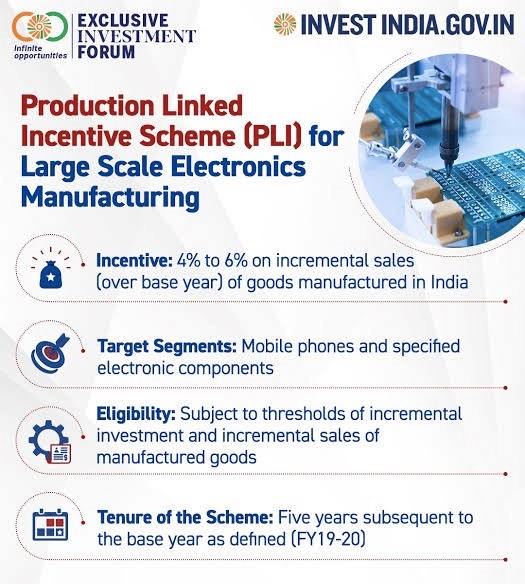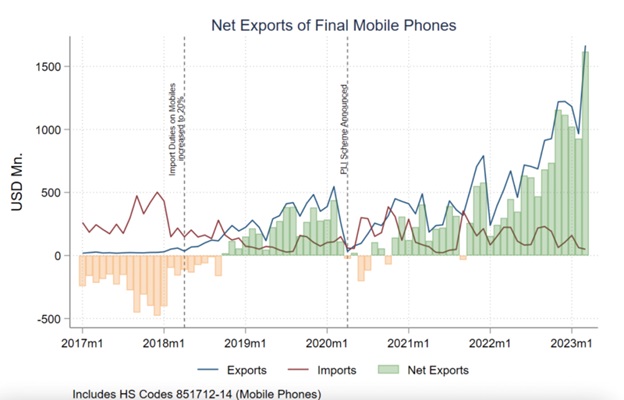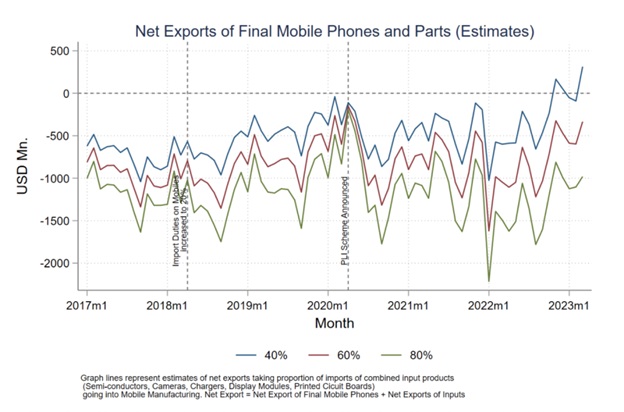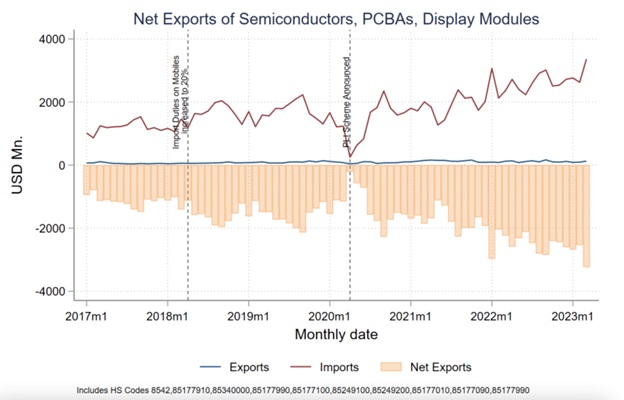On smartphone manufacturing in India.
Relevance
- GS Paper 2: Government Policies & Interventions, GS Paper – 3, Growth & Development, Liberalization.
- Tags: #upsc #rbi #raghuramrajan #governmentpolicies #growth&development.
Why in the news?
Over the last few months, former RBI governor Raghuram Rajan and the Minister of State for Electronics Rajeev Chandrasekhar have sparred over how well a Central government scheme to boost electronics manufacturing has been faring.
The issue
- It started when Mr. Rajan, along with two other economists, released a brief discussion paper arguing that the programme isn’t really pushing India towards becoming a self-sufficient manufacturing powerhouse.
- Instead, the government is using taxpayer money to create an ecosystem of low-level assembly jobs that will still depend heavily on imports.
The PLI scheme
- Around five years ago, the Government of India decided it wanted more companies to make things in India.
- Manufacturing is a key ingredient to economic growth and also comes with what economists call a multiplier effect — every job created and every rupee invested in manufacturing has a positive cascading effect on other sectors in the economy.
- However, the problem was that many industries didn’t want to set up shop in the country.
- India’s infrastructure isn’t great, the country’s labor laws are archaic, and the workforce isn’t very skilled.
- To solve this, the government used, and uses, a carrot-and-stick approach. The ‘stick’ is raising import duties, thus making it more expensive for companies to import stuff from somewhere else and sell it in India. The ‘carrot’ is to provide subsidies and incentives.
- One key set of incentives is the production-linked incentives (PLI) scheme. Here, the government gives money to foreign or domestic companies that manufacture goods here. The annual payout is based on a percentage of revenue generated for up to five years.
- The industry that has shown the most enthusiasm for the scheme is smartphone manufacturing.
- Companies like Micromax, Samsung, and Foxconn (which makes phones for Apple) can get up to 6% of their incremental sales income through the PLI program.
- And with the scheme, mobile phone exports jumped from $300 million in FY2018 to an astounding $11 billion in FY23. And while India imported mobile phones worth $3.6 billion in FY2018, it dropped to $1.6 billion in FY23.
The PLI schemes have several features that make them different from the previous incentive schemes. Some of these features are
Output-oriented
- The schemes are output-oriented rather than input-based. They reward manufacturers for increasing their production and sales rather than for investing in capital or infrastructure.
Time-bound
- The schemes are time-bound and have a sunset clause. They are valid for a period of five to six years depending on the sector.
Performance-based
- The schemes are performance-based and have a graded incentive structure. The incentive rate varies according to the category of the manufacturer (domestic or foreign), the level of value addition, the type of product and the year of operation.
Flexible
- The schemes are flexible and allow manufacturers to choose their own base year, investment plan and production targets within the prescribed guidelines.
Aligned with the national priorities
- The schemes are aligned with the national priorities and strategic sectors. They aim to reduce import dependence, promote innovation and R&D, create employment opportunities and enhance India’s share in the global value chain.
The PLI schemes have several significances for the Indian economy and society. Some of these significances are
Boost Manufacturing
- The schemes can boost India’s manufacturing output and exports by creating a conducive environment for domestic and foreign investors.
- According to government estimates, the PLI schemes can generate additional production worth Rs 37.5 lakh crore ($500 billion) and additional exports worth Rs 20 lakh crore ($267 billion) over five years.
Enhance self-reliance and resilience
- The schemes can enhance India’s self-reliance and resilience in critical sectors such as electronics, pharmaceuticals, telecom and renewable energy. These sectors have high import dependence and strategic importance for India’s development and security.
Foster innovation
- The schemes can foster innovation and R&D in emerging technologies such as electric vehicles, 5G, artificial intelligence and biotechnology. These technologies have immense potential for transforming various sectors and improving the quality of life of people.
Employment opportunities
- The schemes can create employment opportunities for millions of people across various skill levels. According to government estimates, the PLI schemes can create direct employment for 1.8 million people and indirect employment for several more over five years.
The PLI schemes also face some challenges and limitations that need to be addressed for their effective implementation and impact. Some of these challenges are
Monitoring and evaluation mechanism
- The schemes require a robust monitoring and evaluation mechanism to ensure transparency, accountability and compliance of the manufacturers.
- The government needs to establish clear criteria and indicators for measuring the incremental production, sales and value addition of the manufacturers and verify them through independent audits.
Coordinated approach
- The schemes require a coordinated approach among various ministries, departments, agencies and stakeholders to avoid duplication, overlap or conflict of policies and regulations.
- The government needs to harmonize the PLI schemes with other existing or proposed schemes such as Make in India, Digital India, Startup India, etc.
Supportive ecosystem
- The schemes require a supportive ecosystem of infrastructure, logistics, finance, skilling and market access to enable the manufacturers to scale up their production and exports. The government needs to address the bottlenecks and gaps in these areas through reforms and investments.
Dynamic and responsive design
- The schemes require a dynamic and responsive design to adapt to the changing market conditions and consumer preferences. The government needs to review and revise the PLI schemes periodically based on feedback from the manufacturers and other stakeholders.
The glitches
- The export boom hides more than it reveals. While imports of fully put-together mobile phones have come down, the imports of mobile phone components — including display screens, cameras, batteries, printed circuit boards — shot up between FY21 and FY23.
- Incidentally, these are the same two years when mobile phone exports jumped the most. This matters because manufacturers aren’t really making mobile phones in India in the traditional sense.
- That would involve their supply chain also moving to India and making most of the components here as well.
- This is important as low-level assembly work doesn’t produce well-paying jobs and doesn’t nearly have anywhere the same multiplier effect that actual manufacturing might provide.
To ensure the success of the PLI Scheme and harness its full potential:
- The government should streamline the processes and procedures for applying, approving, disbursing and auditing the incentives, to reduce delays, complexities and leakages.
- The government should allocate adequate funds for the scheme transparently and predictably while ensuring fiscal prudence and accountability.
- The government should adopt a holistic and balanced approach to select the sectors and firms for the scheme, based on their economic viability, social relevance and environmental impact.
- The government should complement the scheme with other supportive measures, such as infrastructure development, skill development, ease of doing business, tax reforms and regulatory reforms.
- The government should engage with other countries and regions, through bilateral or multilateral dialogues, to address their concerns and resolve any trade issues arising from the scheme.
Conclusion
- The main divide is over whether the PLI programme will be able to create long-lasting jobs and firmly establish India as a manufacturing and supply hub that adds value to the production process
- The PLI schemes are a bold and ambitious step by the Government of India to revitalize the manufacturing sector and make India a global hub for production and innovation.
- The success of these schemes depends on their effective implementation and coordination among various actors. If done well, these schemes can transform India’s economic landscape and create a new wave of growth and development.
Source: The Hindu
Mains Question
The Production Linked Incentive (PLI) schemes are a set of initiatives to boost domestic manufacturing and attract foreign investments in various sectors. What are the main benefits and challenges of these schemes for the Indian economy and industry, and what are the possible solutions to overcome the hurdles and enhance the manufacturing capacity and competitiveness of the country?







